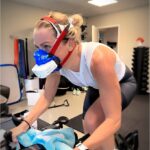For athletes, maximizing performance and achieving peak fitness levels often require a deeper understanding of how the body responds to exercise. One of the most reliable indicators of cardiovascular fitness and endurance is VO2 max. VO2 max testing provides invaluable insights into how efficiently your body uses oxygen during intense physical activity. In this comprehensive guide, we’ll explain what VO2 max is, why it matters for athletes, and how you can use testing to improve your training, performance, and overall fitness.
What is VO2 Max?
VO2 max, or maximal oxygen uptake, is the maximum amount of oxygen your body can utilize during intense exercise. It’s considered the gold standard for assessing aerobic capacity and cardiovascular fitness. Essentially, it measures the efficiency of your heart, lungs, and muscles in delivering and utilizing oxygen while performing strenuous activity. The higher your VO2 max, the better your cardiovascular system is at supplying oxygen to your muscles, which means you can perform at higher intensities for longer periods.
Why VO2 Max Matters for Athletes
For athletes, VO2 max is a key indicator of endurance. Whether you’re a long-distance runner, cyclist, swimmer, or competing in any other endurance sport, a higher VO2 max allows you to sustain activity for longer without tiring. This gives you a significant advantage in races and competitions.VO2 max isn’t only relevant for runners or cyclists—any athlete who requires cardiovascular fitness can benefit from it. For example, team sport athletes (like soccer players, basketball players, or football players) can perform better during high-intensity bursts of activity and recover more quickly in between.VO2 max testing offers athletes an accurate way to monitor improvements in cardiovascular fitness. It serves as a baseline for measuring progress, so you can see how your training is impacting your endurance and aerobic capacity. This can be a motivating factor in your training regimen.Understanding your VO2 max gives you the ability to personalize your training program. By knowing where your aerobic capacity stands, you can focus on specific areas that need improvement. Whether you need to enhance endurance, anaerobic capacity, or recovery time, your VO2 max data provides the guidance needed to optimize your workouts.
How is VO2 Max Testing Performed?
VO2 max testing is typically conducted in a laboratory or clinical setting, though it may also be available at specialized sports performance centers and fitness clinics. The test requires you to exercise at progressively higher intensities while wearing a mask or mouthpiece connected to a machine that measures the oxygen you’re consuming.The test begins with a light warm-up to prepare your body for the exercise.You’ll then start exercising on a treadmill, stationary bike, or another piece of cardio equipment. The intensity of the exercise will gradually increase every few minutes, making it progressively more difficult until you can no longer maintain the effort.Throughout the test, you’ll wear a mask or mouthpiece that collects data on how much oxygen you’re inhaling and how much carbon dioxide you’re exhaling. The machine analyzes these gases to calculate your VO2 max.The test continues until you reach your maximum effort, often signified by reaching exhaustion or being unable to continue the required pace.After the test, the results are analyzed, providing you with your VO2 max score. The data can also include information on your lactate threshold (the point at which lactate builds up in the muscles), heart rate zones, and breathing efficiency.
How to Improve Your VO2 Max
Improving your VO2 max takes dedication and targeted training. Here are some of the most effective strategies for boosting your VO2 max.HIIT workouts involve alternating between short bursts of intense exercise and periods of lower-intensity recovery. This method helps improve both aerobic and anaerobic capacity, making it one of the most effective ways to increase VO2 max.Long, steady-state aerobic exercises such as running, cycling, or swimming can improve cardiovascular endurance and increase VO2 max. Consistent endurance training forces your heart and lungs to work more efficiently, boosting oxygen uptake over time.Structured interval training with progressively increasing intensity will improve your ability to sustain higher intensities. For example, you might alternate between periods of running at race pace and slower recovery periods. While strength training is not traditionally associated with VO2 max, it can contribute to improvements by increasing muscle efficiency. Stronger muscles require less oxygen to perform work, which can improve overall aerobic capacity.
How Often Should You Test Your VO2 Max?
The frequency of VO2 max testing depends on your fitness goals and training cycle. Athletes typically test their VO2 max once every 3 to 6 months to monitor progress and adjust their training plans. However, more frequent testing can be beneficial for tracking incremental changes and ensuring that your training is on the right path.Long-distance runners, cyclists, and triathletes can greatly benefit from VO2 max testing to measure their aerobic capacity and tailor their training for peak performance. VO2 max testing helps players in sports like soccer, basketball, and football understand their stamina and ability to perform during high-intensity bursts of activity.Even for those who aren’t competing at elite levels, VO2 max testing can provide valuable insights into current fitness levels and guide improvements in cardiovascular health.
Conclusion
For athletes, VO2 max testing is more than just a fitness metric—it’s a powerful tool to enhance endurance, improve performance, and refine training programs. By understanding how efficiently your body uses oxygen during exercise, you can target specific areas for improvement and make smarter decisions about your workouts. Regular VO2 max testing provides a clear picture of your fitness progress and helps you take your performance to the next level.

